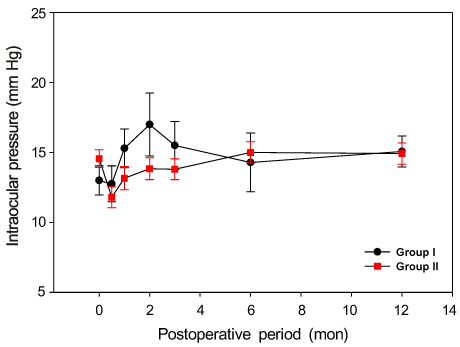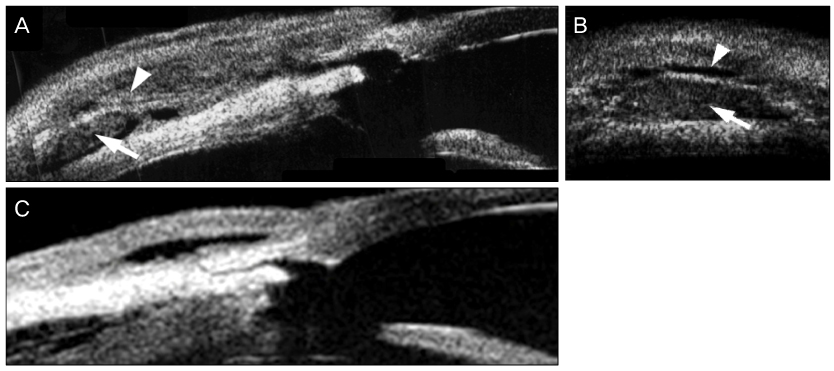J Korean Ophthalmol Soc.
2012 Feb;53(2):297-305.
The Analysis of the Clinical Findings and Effects of Biodegradable Collagen Matrix in Trabeculectomy
- Affiliations
-
- 1Department of Ophthalmology, Ulsan University Hospital, Ulsan University College of Medicine, Ulsan, Korea. yimjinho@hanmail.net
- 2Department of Ophthalmology, Samsung Medical Center, Sungkyunkwan University College of Medicine, Seoul, Korea.
Abstract
- PURPOSE
To observe the effects of biodegradable collagen matrix (OculusGen(TM)) on filtering bleb formation and maintenance and to investigate its clinical effects and usefulness in trabeculectomy.
METHODS
Ophthalmologic examinations were preformed 1 day, 2 weeks, 1 month, 2 months, 3 months, 6 months, and 12 months postoperatively in the case and control groups. The clinical findings of the filtering bleb were observed, and the clinical effects measured by mean intraocular pressure and complications were evaluated in both groups.
RESULTS
The success rates were 76% in the case group and 88% in the control group, and there were no significant differences between the case and control groups. In the case group, postoperative conjunctival injection persisted for more than 1 month with increasing severity, while ultrasound biomicroscopy revealed increased echogenicity of the subconjuctival and tenon tissue with no definite space-occupying effect.
CONCLUSIONS
Trabeculectomy utilizing collagen matrix showed similar clinical results compared to the current traditional trabeculectomy; slit-lamp and ultrasound biomicroscopy findings did not reveal any advantageous changes to filtering bleb function.
Figure
Reference
-
1. Skuta GL, Parrish RK II. Wound healing in glaucoma filtering surgery. Surv Ophthalmol. 1987. 32:149–170.2. Franks WA, Hitchings RA. Complications of 5--flourouracil after trabeculectomy. Eye (Lond). 1991. 5:385–389.3. Sinnreich Z, Barishak R, Stein R. Leaking filtering blebs. Am J Ophthalmol. 1978. 86:345–349.4. Greenfield DS, Suñer IJ, Miller MP, et al. Endophthalmitis after filtering surgery with mitomycin. Arch Ophthalmol. 1996. 114:943–949.5. Chen HS, Ritch R, Krupin T, Hsu WC. Control of filtering bleb structure through tissue bioengineering: An animal model. Invest Ophthalmol Vis Sci. 2006. 47:5310–5314.6. Hsu WC, Ritch R, Krupin T, Chen HS. Tissue bioengineering for surgical bleb defects: an animal study. Graefes Arch Clin Exp Ophthalmol. 2008. 246:709–717.7. Cairns JE. Trabeculectomy: Preliminary report of a new method. Am J Ophthalmol. 1968. 66:673–679.8. Watson PG, Barnett F. Effectiveness of trabeculectomy in glaucoma. Am J Ophthalmol. 1975. 79:831–845.9. Benedikt OP. Drainage mechanism after filtration. Glaucoma. 1979. 1:71–77.10. Kronfeld FC. The chemical demonstration of transconjunctival passage of aqueous after antiglaucomatous operations. Am J Ophthalmol. 1952. 35:38–45.11. Azuara-Blanco A, Katz LJ. Dysfunctional filtering blebs. Surv Ophthalmol. 1998. 43:93–126.12. Palmer SS. Mitomycin as adjuct chemotherapy with trabeculectomy. Ophthalmology. 1991. 98:317–321.13. Chen CW. Enhanced intraocular pressure controlling effectiveness of trabeculectomy by local application of mitomycin-C. Trans Asia Pac Acad Ophthalmol. 1983. 9:172–177.14. The Flourouracil Filtering Surgery Study Group. Flourouracil Filtering Surgery Study one-year follow up. Am J Ophthalmol. 1989. 108:625–635.15. Khaw Pt, Sherwood MB, Doyle JW, et al. Intraoperative and post-operative treatment with 5-flourouracil and mitomycin-c: Long term effects in vivo on subconjunctival and scleral fibroblast. Int Ophthalmol. 1992. 16:381–385.16. Duke-Elder S, Ashton N. Action of cortisone on tissue reactions of inflammation and repair with special reference to the eye. Br J Ophthalmol. 1951. 35:695–707.17. Starita RJ, Fellman RL, Spaeth GL, et al. Short- and long-term effects of postoperative corticosteroids on trabeculectomy. Ophthalmology. 1985. 92:938–946.18. Stamper RL, Mcmenemy MG, Lieberman MF. Hypotonous maculopathy after trabeculectomy with subconjunctival 5-flourouracil. Am J Ophthalmol. 1992. 114:544–553.19. Hong SJ, Lee JR, Choi JY, et al. Trabeculectomy with biodegradable collagen material: A report of two cases. J Korean Ophthalmol Soc. 2010. 51:912–918.20. Hong SJ, Lee JR, Kim YD, et al. Fibrous encapsulation of biodegradable collagen matrix after trabeculectomy: A case report. J Korean Ophthalmol Soc. 2010. 51:631–635.21. Mietz H, Arnold G, Kirchhof B, et al. Histopathology of episcleral fibrosis after trabeculectomy with and without mitomycin C. Graefes Arch Clin Exp Ophthalmol. 1996. 234:364–368.22. Joseph JP, Miller MH, Hitchings RA. Wound healing as a barrier for successful filtration surgery. Eye. 1988. 2:Suppl. S113–S123.23. Papaconstantinou D, Georgalas I, Karmiris E, et al. Trabeculectomy with OloGen versus trabeculectomy for the treatment of glaucoma: A pilot study. Acta Ophthalmol. 2010. 88:80–85.24. Rosentreter A, Schild AM, Jordan JF, et al. A prospective randomized trial of trabeculectomy using mitomycin C vs an ologen implant in open angle glaucoma. Eye. 2010. 24:1449–1457.
- Full Text Links
- Actions
-
Cited
- CITED
-
- Close
- Share
- Similar articles
-
- Fibrous Encapsulation of Biodegradable Collagen Matrix After Trabeculectomy: A Case Report
- Trabeculectomy With Biodegradable Collagen Material: A Report of Two Cases
- Comparison of Effects and Complications between Conventional Trabeculectomy and Trabeculectomy with a Collagen Matrix Insertion
- Behavior of Fibroblasts on a Porous Hyaluronic Acid Incorporated Collagen Matrix
- A Clinical Evaluations of Trabeculectomy






